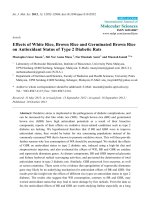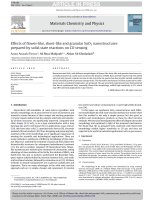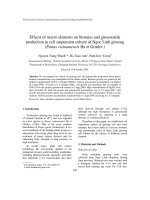- Trang chủ >>
- Khoa Học Tự Nhiên >>
- Vật lý
effects of flower - like, sheet - like and granular sno2 nanostructures
Bạn đang xem bản rút gọn của tài liệu. Xem và tải ngay bản đầy đủ của tài liệu tại đây (756.21 KB, 4 trang )
Please cite this article in press as: A.A. Firooz, et al., Effects of flower-like, sheet-like and granular SnO
2
nanostructures prepared by solid-state
reactions on CO sensing, Mater. Chem. Phys. (2008), doi:10.1016/j.matchemphys.2008.11.028
ARTICLE IN PRESS
G Model
MAC-13055; No.of Pages4
Materials Chemistry and Physics xxx (2008) xxx–xxx
Contents lists available at ScienceDirect
Materials Chemistry and Physics
journal homepage: www.elsevier.com/locate/matchemphys
Effects of flower-like, sheet-like and granular SnO
2
nanostructures
prepared by solid-state reactions on CO sensing
Azam Anaraki Firooz
a
, Ali Reza Mahjoub
a,∗
, Abbas Ali Khodadadi
b
a
Department of Chemistry, Tarbiat Modares University, 14115-175 Tehran, Iran
b
School of Chemical Engineering, University of Tehran, 11155-4563 Tehran, Iran
article info
Article history:
Received 19 August 2008
Received in revised form 29 October 2008
Accepted 17 November 2008
Keywords:
SEM
XRD
Semiconductor
Nanostructures
abstract
Nanostructured SnO
2
with different morphologies of flower-like, sheet-like and granular have been suc-
cessfully prepared viaa solid-state reaction in the presence of NaBr, NaCl, and NaF, respectively. The added
salts not only prevent a drastic increase in the size of the tin species but also provide suitable conditions
for the oriented growth of primary nanoparticles. The formation mechanisms of these materials by solid-
state reaction at ambient temperature are proposed. The gas sensitivity experiments have demonstrated
that the as-synthesized SnO
2
especially, flower-like morphology, exhibit high sensitivity to CO, which
may of fer potential applications in gas sensors.
© 2008 Elsevier B.V. All rights reserved.
1. Introduction
Hierarchical self-assemblies of nano-/micro-crystallites with
specific morphology are of great interest in areas of chemistry and
materials science because of their unique and exciting properties
[1]. Some reports indicate that the catalytic selectivity and sensitiv-
ity of these structures are significantly improved, compared with
other shapes [2,3]. SnO
2
is an n-type semiconductor with a long
band gap [4], and is well known for its applications in gas sensors
[5,6], dye-base solar cells [7], optoelectronic devices [8], electrode
materials [9] andcatalysts [10]. Thus, designing andpreparing SnO
2
materials with novel morphology are of significant importance in
meeting the scientific and technological applications. There are
many methods to synthesize of different morphology of this mate-
rial. Ohgi et al. reported the evolution of nanoscale SnO
2
flakes into
hierarchically structures by subsequent hydrothermal treatment
[11]. Xie and co-workers prepared 2D hierarchical SnO
2
flower-
like nanostructures without post-treatment of calcinations, taking
advantage of slow oxidation of tin foil by the solution of KBrO
3
and
NaOH [12]. Mu and co-workers synthesized the flowerlike SnO
2
quasi-square submicrotubes by reaction between SnCl
2
and oxalic
acid in ethanol solution, followed by calcination in air[13]. All these
methods to dioxide nanoparticles are in general complicated and
expensive. There are many advantages in the solid-state reaction
approach such as: (a) simple, cheaper and convenient; (b) involve
∗
Corresponding author. Tel.: +98 21 82883442; fax: +98 21 88007930.
E-mail address: (A.R. Mahjoub).
less solvent and reduce contamination; (c) give high yields of prod-
ucts [14].
In this paper, we synthesize SnO
2
nanostructures with differ-
ent morphologies by solid-state reaction method. Our studies show
that this method is not only a simple process but also gives as
uniform and monodisperse products as those by other lucrative
methods.Wehavealso investigated theeffect ofhalogen saltsonthe
morphology and explained in light of the proposed mechanisms.
We found that the as-prepared SnO
2
materials with flower-like
morphology exhibit higher sensitivity to CO gas and thus are
expected to be useful in industrial applications such as gas sensors.
2. Experimental
2.1. Preparation
A mixture of SnCl
2
·2H
2
O (0.01mol, 3.51 g) and NaOH (0.038 mol, 2.13 g) pow-
ders was ground for 30 min. Then, each of NaBr, NaCl, and NaF halogen salt with a
weight ratio of 2:1 was added to the system and ground for another 30 min at room
temperature. The reaction began immediately during the mixing process (accom-
panying an emission of water vapor from the system). The products dried in air to
yield black SnO powder. The powder was calcined at 40 0 and 600
◦
C for 2h in air
and washed with distilled water for removing the halogen salt and dried in 80
◦
C.
2.2. Characterization
The morphology of tin oxide powders was determined by using scanning
electron microscopy (SEM) of a Holland Philips XL30 microscope. X-ray powder
diffraction (XRD) patterns of the powders were recorded in ambient air with using
a Holland Philips Xpert X-ray powder diffraction (Cu K␣, = 1.5406 Å), at scanning
speed of 2
◦
min
−1
from 20
◦
to 80
◦
(2Â). Specific surface area of SnO
2
nanoparticles
were determined by nitrogen adsorption, after degassing at 300
◦
C for 2 h, using a
surface area analyzer (CHEMBET 3000) and BET method.
0254-0584/$ – see front matter © 2008 Elsevier B.V. All rights reserved.
doi:10.1016/j.matchemphys.2008.11.028
Please cite this article in press as: A.A. Firooz, et al., Effects of flower-like, sheet-like and granular SnO
2
nanostructures prepared by solid-state
reactions on CO sensing, Mater. Chem. Phys. (2008), doi:10.1016/j.matchemphys.2008.11.028
ARTICLE IN PRESS
G Model
MAC-13055; No.of Pages4
2 A.A. Firooz et al. / Materials Chemistry and Physics xxx (2008) xxx–xxx
Fig. 1. XRD patterns of flower-like (NaBr) calcined at: (a) 400
◦
C (NaBr400); (b)
600
◦
C (NaBr600) for 2h.
2.3. Gas sensing measurement
A paste of tin oxide powder was applied on an aluminatube with gold electrodes
already deposited on it. The sample was dried and calcined at 400
◦
C. Thus obtained
sensor was placed in a glass holder immersed in a molten salt bath, temperature
of which was accurately controlled by a PID temperature controller. The sensor was
connected to an electrical circuit using platinum electrodes. The DC electrical mea-
surement was made by using an applied voltage of 4.0 V onto a known resistance in
series with the sensor. The DC voltage across the sensor was read out using an A/D
converter and data was transferred to the computer for further processing. The sen-
sor response was measured at different temperatures in the presence of 1000 ppm
CO in air.
3. Result and discussion
3.1. Tin oxide morphology
The structure of tin oxide powders was determined by XRD,
as shown in Figs. 1–3. Major SnO
2
cassiterite structure (JCPDS
no. 41-1445) is observed in all XRD patterns. The marked peaks
Fig.2aand3a are attributed to SnOphase(JCPDS no.6-395), which is
stable up to 400
◦
C. The ratio of (1 01) SnO peak to (1 10) SnO
2
peak
intensities, as a semiquantitative measure of SnO/SnO
2
ratio, are
included in Table 1. After calcination at600
◦
C, the (10 1) diffraction
peak intensity of SnO is reduced, as shown in Fig. 2b and 3b. All XRD
patterns show that, when the calcination temperature increases,
the intensity of the diffraction peaks increases, indicating a high
degree ofcrystallinity andgrain sizes ofthenanoparticles. The crys-
tal grain sizes were calculated from the FWHMin XRD pattern using
the Debye–Scherrer’s equation and listed in Table 1.
Scanning electron microscopy was employed to study the mor-
phologies of the tin oxide samples. Fig. 4a–c shows that flower-like,
sheet-like, and granular morphologies of tin oxide are formed,
when NaBr, NaCl, or NaF halogen salts are used in the salt-assisted
solid-state synthesis, respectively. The flower-like morphology
reveals that the structure is built up many sheet-like nanoparticles.
Fig. 2. XRD patterns of sheet-like (NaCl) calcined at: (a)40 0
◦
C (NaCl400); (b) 600
◦
C
(NaCl600) for 2h.
Fig. 3. XRD patterns of nanoparticle (NaF)calcined at: (a) 400
◦
C (NaF400); (b)600
◦
C
(NaF600) for 2h.
3.2. Growth mechanism of SnO
2
nanostructures
Li et al. have proposed that in the first step of the solid-state
reaction, SnO fine particles are formed [15]. The reaction is often
self-initiated and self-sustained with H
2
O vapor releasing after
grinding of the mixture of the precursors. After the calcination at
400or600
◦
C, the SnO is mostly converted to SnO
2
nanoparticles.
It is well known that the structure of products by a solid-state reac-
tion depends on the rate of nucleationand growth. It isalsothought
that adding inorganic salts causes to reduce the overall reaction
rate and broaden the distribution of product. NaBr, NaCl, and NaF
as salt-assisted additives are expected to cause cage-like shells
surrounding the SnO particles, preventing their growth. Adjacent
nanoparticles rotate to find the low-energy configuration repre-
sented by a coherent particle–particle interface [16]. As a result, the
added salts help to form of suitable morphology with high yields.
Table 1
The sizes, sensitivity, semiquantitative measure of SnO/SnO
2
ratio and physical properties of the as prepared materials.
Samples Color Morphology Crystallite size (nm) Sensitivity Surface area (m
2
g
−1
) Grain size (nm) SnO/SnO
2
(ratio of peaks intensity)
NaBr400 Pale Flower-like 16.78 71.5 45 19.18 0
NaBr600 White Flower-like 20.52 9.88 25 34.53 0
NaCl400 Gray Sheet-like 19.26 7.46 34.6 24.95 1/3
NaCl600 Pale Sheet-like 25.72 17.7 14.09 61.27 1/7
NaF400 Brown Nanoparticle 10.59 4.181 49 17.6 1/4
NaF600 Brown Nanoparticle 15.95 16.34 30 28.77 1/8
Please cite this article in press as: A.A. Firooz, et al., Effects of flower-like, sheet-like and granular SnO
2
nanostructures prepared by solid-state
reactions on CO sensing, Mater. Chem. Phys. (2008), doi:10.1016/j.matchemphys.2008.11.028
ARTICLE IN PRESS
G Model
MAC-13055; No.of Pages4
A.A. Firooz et al. / Materials Chemistry and Physics xxx (2008) xxx–xxx 3
Fig. 4. The SEM images of (a) NaBr (flower-like), (b) NaCl (sheet-like), and (c) NaF (granular).
3.3. CO sensing
The CO sensitivity is defined as S =R
air
/R
CO
where R
air
and R
CO
are resistances of the tin oxide in air and in CO, respectively [17].
Figs. 5–7 show the changes in sensitivity of the tin oxide materi-
als calcined at 400 and 600
◦
C, when their thick-film sensors were
exposed to CO at various temperatures. Maximum sensitivities
occur at about 275–300
◦
C for all sensor materials at the two calci-
Fig. 5. Temperature-dependent sensitivity of SnO
2
flower-like (NaBr). (a) NaBr 400;
(b) NaBr 600.
nation temperatures. The highest maximum sensitivity is observed
for the flower-like morphology calcined at 400
◦
C. Calcination at
the higher temperature of 600
◦
C leads to an increase in the grain
sizes, as indicated by XRD and BET results (Table 1). Lower sensitiv-
ities are observed for the sheet-like and granular morphologies. As
the calcination temperature increases from 400 to 60 0
◦
C, the max-
imum sensitivities of sheet-like and granular tin oxides increase,
while their grain sizes increase (see Table 1 and Figs. 6 and 7). The
Fig. 6. Temperature-dependent sensitivity of SnO
2
sheet-like (NaCl). (a) NaCl 400;
(b) NaCl 600.
Please cite this article in press as: A.A. Firooz, et al., Effects of flower-like, sheet-like and granular SnO
2
nanostructures prepared by solid-state
reactions on CO sensing, Mater. Chem. Phys. (2008), doi:10.1016/j.matchemphys.2008.11.028
ARTICLE IN PRESS
G Model
MAC-13055; No.of Pages4
4 A.A. Firooz et al. / Materials Chemistry and Physics xxx (2008) xxx–xxx
Fig. 7. Temperature-dependent sensitivity of SnO
2
granular (NaF). (a) NaF 400; (b)
NaF 600.
XRD patterns of the same samples show the presence of stannic
suboxide (i.e. SnO), which decreases as the calcination temperature
increases.
The sensitivity to a target gas strongly depends on the ease of
diffusion ofgas molecules insidethe sensor[18–20]. Thus,the struc-
ture and morphology of materials can be correlated with the sensor
performance. Flower-like SnO
2
consists of numerous nanoparticles
joined together into flower-like structure, resulting in much more
active exposed sites for gas chemisorptions. Thus, the realization of
a high sensitivity of flower-like morphology may be explained in
terms of rapid gas diffusion onto the entire sensing surface due to
the specific morphology of this material.
Usually the gas sensitivity of metal oxide semiconductors
decreases, as their sizes increase, due to lower surface areas and
defect density [21]. It sounds that, the presence of tin with lower
oxidation state in tin oxide sensors diminishes their sensitivity to
reducing gases such as CO [22,23]. On the other hand, the presence
of SnO causes a decrease in oxygen vacancies in the samples.
Therefore, not only the morphology but also the presence of
SnO in sheet-like and granular tin oxides, contributes to their lower
sensitivity to CO.
4. Conclusion
We report the preparation of flower-like, sheet-like and granu-
lar morphologies of SnO
2
by solid-state reactions in the presence of
NaBr, NaCl, and NaF salts, respectively. The salts added are expected
to cause cage-like shells surrounding the SnO particles, prevent-
ing their growth of nanoparticles. Adjacent nanoparticles rotate
to find the low-energy configuration represented by a coherent
particle–particle interface, resulting in particular morphologies.
The gas sensitivity experiments showed that the SnO
2
flower-
like offered higher sensitivity than SnO
2
sheet-like and granular.
The high sensitivity may be explained in terms of rapid gas dif-
fusion onto the sensing surface. In addition, the XRD results reveal
the presence of a stannic suboxide, which explains in part the lower
sensitivity to CO shown by the sheet-like and granular nanostruc-
tures.
Acknowledgments
Supports for this investigation by Tarbiat Modares University
and University of Tehran are gratefully acknowledged.
References
[1] C. Sun, J. Sun, G. Xiao, H. Zhang, X. Qiu, H. Li, L. Chen, J. Phys. Chem. B 110 (2006)
13445.
[2] X. Li, Y. Xiong, Z. Li, Y. Xie, Inorg. Chem. 45 (2006) 3493.
[3] Y. Zhang, X. He, J. Li, Z. Miao, F. Huang, Sens. Actuators B: Chem. 132 (2008) 67.
[4] A.A. Firooz, A.R. Mahjoub, A.A. Khodadadi, Mater. Lett. 62 (2008) 1789.
[5] F. Pourfayaz, A. Khodadadi, Y. Mortazavi, S.S. Mohajerzadeh, Sens. Actuators B:
Chem. 108 (2005) 172.
[6] G.X. Wang, J.S. Park, M.S. Park, X.L. Goua, Sens. Actuators B: Chem. 131 (2008)
313.
[7] N. Amin, T. Isaka, A. Yamada, M. Konagai, Sol. Energy Mater. Sol. Cells 67 (2000)
95.
[8] J.Q. Hu, Y. Bando, D. Golberg, Chem. Phys. Lett. 372 (2003) 758.
[9] J.J. Rowlette, H.I. Attia, Proc. Electrochem. Soc. (1987) 7.
[10] S.R. Stampfl, Y. Chen, J.A. Dumesis, C. Niu, C.G. Hill, J. Catal. 105 (1987) 445.
[11] H. Ohgi, T. Maeda, E. Hosono, S. Fujihara, H. Imai, Cryst. Growth Des. 5 (2005)
1079.
[12] Q. Zhao, Z. Li, C. Wu, X. Bai, Y. Xie, J. Nanopart. Res. 8 (2006) 1065.
[13] H. Sun, S Z. Kang, J. Mu, Mater. Lett. 61 (2007) 4121.
[14] Y M. Zhou, X Q. Xin, Inorg. Chem. 15 (1999) 273.
[15] F. Li, L. Chan, Z. Chance, J. Cub, J. Shuck, X. Xin, Mater. Chem. Phys. 73 (2002)
335.
[16] J. Banfield, S. Welch, H. Zhang, T. Ebert, R. Penn, Science 289 (2000) 751.
[17] L.H. Qian, K. Wang, Y. Li, H.T. Fang, Q.H. Lu, X.L. Ma, Mater. Chem. Phys. 100
(2006) 82.
[18] C.S. Moon, H R. Kim, G. Auchterlonie, J. Drennan, J H. Lee, Sens. Actuators B:
Chem. 131 (2008) 556.
[19] G. Sakai, N. Matsunaga, K. Shimanoe, N. Yamazoe, Sens. Actuators B 80 (2001)
125.
[20] N. Matsunaga, G. Sakai, K. Shimanoe, N. Yamazoe, Sens. Actuators B 83 (2002)
216.
[21] X J. Huang, Y K. Choi, Sens. Actuators B: Chem. 122 (2007) 659.
[22] C. Bittencourt, E.Llobet, M.A.P. Silva, R. Landers, L. Nieto, K.O.Vicaro, J.E. Sueiras,
J. Calderer, X. Correig, Sens. Actuators B: Chem. 92 (2003) 67.
[23] M.K. Kennedy, F.E. Kruis, H. Fissan, H. Nienhaus, A. Lorke, T.H. Metzger, Sens.
Actuators B: Chem. 108 (2005) 62.









